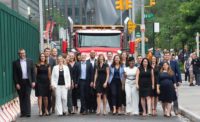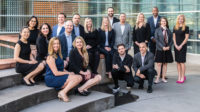Outreach and Representation are Essential to Grow Talent
As it did with every other aspect of society, COVID-19 created new obstacles for STEM education while also spotlighting already existing issues. More than one of the Top 20 group pointed out how virus-related educational setbacks can amplify the challenge of getting more children and young people interested in A/E/C careers, especially those in underrepresented groups—which is a key to growing talent in the industry. “Kids that were going to go to college for STEM are still going to go to college for STEM,” says Bradley J. Lockwood, vice president at Moseley Architects in Raleigh, N.C.
But Lockwood says gaps for kids lacking STEM opportunities should be addressed by wholesale structural changes in education and access improvements that feed into the learning experience. Kyle Roberts, principal and civil engineering department manager at Burns & McDonnell in Kansas City, Mo., agrees. He points to differences in things such as computer and internet access that can affect outcomes in this year of remote learning for many kids. But even with access, “there’s a lot of stuff you just cannot do effectively in the STEM field remotely: labs, experiments, science classes,” Roberts notes. “There’s a huge population of kids now that are not getting that.”
It may take partnerships between universities and K-12 schools to supplement available teaching materials for students, Roberts adds. There are also potential opportunities for firms to “get into [local] communities and help develop STEM programs.”
Many also mentioned the power of individuals in making change. “I think it’s important that we all make it a conscious decision to not only volunteer ourselves,” for example at job fairs, “but also be the cheerleader in our own offices and professional organizations to do the same so that we can kind of all band together,” says Lauren Amber Prestenbach, principal at Powers Brown Architecture in Houston.

Ryan Johnson
What helped me get through the pandemic were my weekly site visits to Fitts-Woolard Hall at NC State to work out issues and check on the progress of the work. With all the uncertainty of 2020, it was rewarding to see a design I had worked on for years come to life.
Peavey points out that “a lot of people, when you look at their trajectory, what made the difference? One person believed in them. And I would just remind everyone that they are one person and that they can be that person.”
Creating opportunity is key, says Joel Vande Boom, project executive at Gilbane Building Co. in Columbus, Ohio. “It’s also about us all seeking, as individuals, as employees, to help,” he adds. “Teach them about those opportunities that are available.”
O’Neill spoke about ways to incentivize action by embedding training program and diversity requirements into a request for proposals (RFP). “One thing that I think the industry can do is change how they’re asking for consultants to respond,” she says. “If they ask, ‘What’s your training program?’ that could help us identify that training program, make the industry respond, make them train up the next generation.”
She says winning work currently focuses too much on subject matter experts who are “put on a pedestal. There’s no incentive to try to show how you’re bringing in diversity, how you’re bringing in the next generation.”
For an industry so rooted in onsite experiences, the lack of that element was felt on the educational level as well. Still, the internet-heavy existence of the past year came with some silver linings. Prestenbach described a virtual job fair that functioned in different ways than a physical one would have, with representatives from different organizations meeting in a shared space. “You had the opportunity to have a different lens on questions and could hear their excitement. That was a unique platform that would not have come about if COVID had not been here.”
The pandemic and the period of economic tumult the industry went through may also make the case for consruction trades as an alternative to college.
“It’s an easier sale when you start talking about tech and vocational schools and training, with everyone complaining about their student loans and how everyone lost their jobs during this,” says Todd.
A stigma on craft training still places emphasis on traditional college education, says Downs. “Until we change that message, maybe we won’t see different results.”
For many, the key to the future is for firms to embrace K-12 schools by providing hands-on, real-world STEM experiences as students return to in-person interactions and learning.
“You can gain extremely valuable experience in a short period of time by having our companies engage with students both in and out of the classroom,” says Andrew Gilstrap, vice president of JE Dunn Construction in Denver.
Anderson wonders, “What if your construction site was so safe that you could bring kids to it? One thing we can do in a pandemic is take the kids outside. There’s definitely an opportunity to get dirty and start learning.” Johnson described a structured version of such an approach developed by the National Organization of Minority Architects: “One thing it has is Project Pipeline, which is a week-long summer camp that’s meant to get kids interested in architecture specifically.”
A complement to providing hands-on activity to drum up interest in AEC careers is building recognition. Victoria Scala, president of Lowy and Donnath Inc. in Long Island City, N.Y., described a prior social media campaign, #IlooklikeanEngineer, geared toward spotlighting women in the field to show kids real-world examples of what an engineer looks like.
A lack of representation influenced Scala to earn a doctorate and go into teaching. “I thought there should be a woman on the faculty,” she says, “and by the time I left, there were seven.”
Lewis agrees, saying that getting kids involved in efforts such as ACE Mentor Program as early as grade school “really helps with that development and providing those types of programs that can help change that narrative. You know what the doctors of the world look like, but there are no shows for engineers.”
Backstory: Powering Through the Pandemic

Andrew Gilstrap
During 13 years of marriage with my wife, Melissa, we’ve focused on building a true partnership with one another that allowed us to adjust quickly to the needs of balancing our two careers, home-school activities and all else that came with adjusting to the pandemic.

Jeyre Lewis
I was able to challenge myself on being more creative to have memorable moments during these tough times with my family: arts and crafts day with my three-year-old daughter, Wednesday wine day with my wife, virtual Saturday game night, etc.

Bradley Lockwood
I have relocated to work in [a] new market [twice]. Establishing a presence in new markets with no existing relationships or a local book of work is extremely challenging and it requires you to be creative about how to capture the attention of potential clients.

Courtney O’Neill
I have always made it a priority to try to get to know people personally and that helped me connect better to colleagues on line. During the pandemic, I pushed my team to share non-work related stories before we jumped into data or business-driven calls.



























